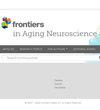前沿 | 缺氧与阿尔茨海默病的关系:最新综述
IF 4.1
2区 医学
Q2 GERIATRICS & GERONTOLOGY
引用次数: 0
摘要
阿尔茨海默病(AD)是最常见的神经退行性疾病之一,也是最常见的痴呆症。诊断阿尔茨海默病的主要标志是细胞外淀粉样蛋白-β(Aβ)斑块沉积和细胞内高度磷酸化的 Tau 蛋白聚集成神经纤维缠结。大脑比其他器官消耗更多的氧气,因此更容易受到缺氧的影响。长期以来,缺氧一直被认为是导致注意力缺失症和其他神经退行性疾病的可能原因之一,但其确切机制尚未明确。在这篇综述中,我们将阐明缺氧诱导因子-1α与AD之间的联系,包括其对AD的作用及其可能的保护作用。此外,我们还将讨论氧化应激与AD之间的关系,因为有证据表明氧化应激作用于与AD相关的致病因素,如线粒体功能障碍、Aβ沉积、炎症等。目前,AD 尚无治愈方法。鉴于缺氧、氧化应激和注意力缺失症之间的密切联系,以及目前关于抗氧化剂对注意力缺失症的保护作用的研究,我们推测抗氧化剂可能是一种潜在的注意力缺失症治疗方法,值得进一步研究。本文章由计算机程序翻译,如有差异,请以英文原文为准。
Frontiers | The relationship between hypoxia and Alzheimer’s disease: an updated review
Alzheimer’s disease (AD) is one of the most common neurodegenerative diseases, and the most prevalent form of dementia. The main hallmarks for the diagnosis of AD are extracellular amyloid-beta (Aβ) plaque deposition and intracellular accumulation of highly hyperphosphorylated Tau protein as neurofibrillary tangles. The brain consumes more oxygen than any other organs, so it is more easily to be affected by hypoxia. Hypoxia has long been recognized as one of the possible causes of AD and other neurodegenerative diseases, but the exact mechanism has not been clarified. In this review, we will elucidate the connection between hypoxia-inducible factors-1α and AD, including its contribution to AD and its possible protective effects. Additionally, we will discuss the relationship between oxidative stress and AD as evidence show that oxidative stress acts on AD-related pathogenic factors such as mitochondrial dysfunction, Aβ deposition, inflammation, etc. Currently, there is no cure for AD. Given the close association between hypoxia, oxidative stress, and AD, along with current research on the protective effects of antioxidants against AD, we speculate that antioxidants could be a potential therapeutic approach for AD and worth further study.
求助全文
通过发布文献求助,成功后即可免费获取论文全文。
去求助
来源期刊

Frontiers in Aging Neuroscience
GERIATRICS & GERONTOLOGY-NEUROSCIENCES
CiteScore
6.30
自引率
8.30%
发文量
1426
期刊介绍:
Frontiers in Aging Neuroscience is a leading journal in its field, publishing rigorously peer-reviewed research that advances our understanding of the mechanisms of Central Nervous System aging and age-related neural diseases. Specialty Chief Editor Thomas Wisniewski at the New York University School of Medicine is supported by an outstanding Editorial Board of international researchers. This multidisciplinary open-access journal is at the forefront of disseminating and communicating scientific knowledge and impactful discoveries to researchers, academics, clinicians and the public worldwide.
 求助内容:
求助内容: 应助结果提醒方式:
应助结果提醒方式:


